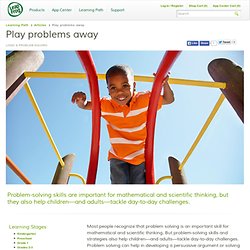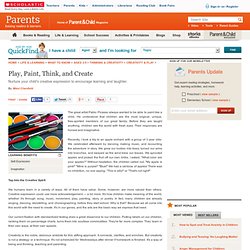

Building Problem Solving Skills Through Play. Most people recognize that problem solving is an important skill for mathematical and scientific thinking.

But problem-solving skills and strategies also help children—and adults—tackle day-to-day challenges. Problem solving can help in developing a persuasive argument or solving an engineering or design challenge. Good problem solvers use creative, flexible thinking and can apply problem-solving strategies to art, math, writing, social situations and more. Researchers and educators typically talk about two aspects of problem-solving: 1) The logic, reasoning, and cognitive skills underlying problem solving abilities, and 2) the strategies and process of solving a problem.
Whether they know it or not, good problem solvers go through a mental process consisting of several steps: Identify the problem.Examine the facts or attributes of the problem.Apply knowledge, tools and skills toward a solution.Evaluate the solution and outcomes. Share the wealth. Why I chose this article. Citation. The Kindergarten Program. Educational articles are an excellent resource for parents who are interested in learning about the best parenting practices from experts in the field.

With insights from top education specialists, these parenting articles provide advice and information for both typical and unusual parenting circumstances. A large range of topics are covered in these educational articles, from back-talking toddlers to college-bound teenagers. There are also articles about best practices to use with kids and teens with specific mental and physical needs. These parenting articles are great for anyone who wants to raise a healthy, happy child.
Popular Articles See All Articles Email. Why I chose this article. Citation. The Wisdom of Play. Why I chose this article. Citation. Child's Creativity. According to the experts, it is possible to encourage or inhibit the development and expression of creativity in young children.

Most theories of child development view young children as highly creative, with a natural tendency to fantasize, experiment, and explore their physical and conceptual environment. However this high level of creativity is not necessarily maintained throughout childhood and into adulthood. The level of creativity declines when they start the kindergarten and peaks again when they reach puberty.
Creativity is essentially a form of problem solving. But it is a special type of problem solving--one that involves problems for which there are no easy answers: that is, problems for which popular or conventional responses do not work. For a proper understanding of children's creativity, one must distinguish creativity from intelligence and talent.
Is your child creative? How can adults encourage creativity? * Choice of materials. . * Creativity does not follow the clock. Why I chose this article. Citation. Play, Paint, Think, and Create. The great artist Pablo Picasso always wanted to be able to paint like a child.

He understood that children are the most original, unique, free-spirited members of our great family. Before they are taught anything, children see the world with fresh eyes. Their responses are honest and imaginative. Recently, I took a trip to an apple orchard with a group of 3 year olds. We celebrated afterward by dancing, making music, and recounting the adventure in story. Tap Into the Creative Spirit We humans learn in a variety of ways. Our current fixation with standardized testing does a great disservice to our children. Creativity is the noble, delicious antidote for this stifling approach. Our greatest role in protecting the creative spirit within our children is to be open to their originality and questions, join in with their playful thinking, and appreciate their singing, building, and painting. Creativity is our birthright.
Four Little Nudges Ask, What else? Why I chose this article. Citation.